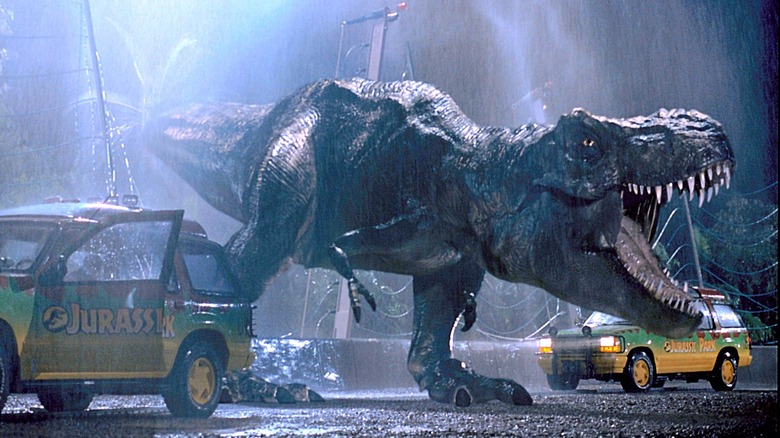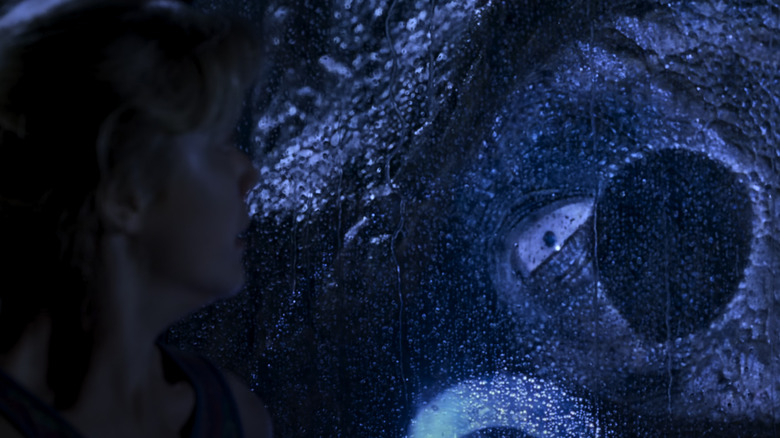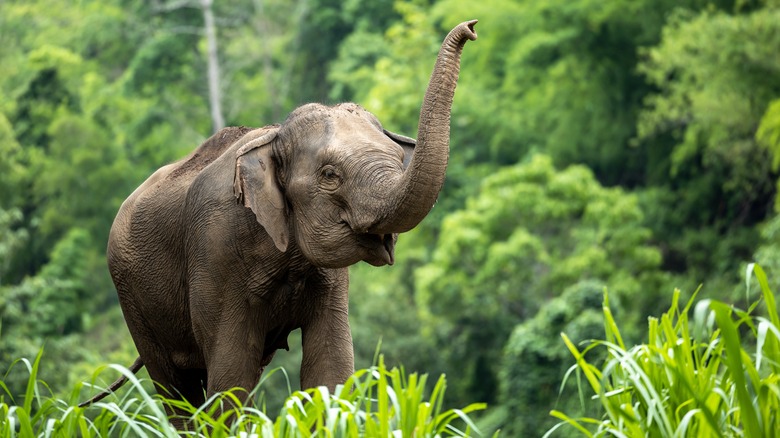Jurassic Park Got Its T-Rex Roar From A Combination Of Three Very Different Animals
It's remarkable how we both know so much and so little about dinosaurs. Since Megalosaurus was first described by William Buckland in 1824, these long-gone animals have captivated us. However, we are separated from them by millions of years, so barring some fantastic scientific breakthroughs, no one will ever actually see a live dinosaur. Reassembled fossils can only give us the blueprint; we'll never know what they truly looked like, how they behaved, or what they sounded like.
This fascination with dinosaurs is why the premise of "Jurassic Park" found such purchase in pop culture. In-universe the park itself plays on humanity's dream of seeing dinosaurs, and for cinemagoers in the real world, this was the first time dinosaurs had been so convincingly depicted in live-action. I guarantee that without "Jurassic Park," we wouldn't have gotten prehistoric nature documentaries, from "Walking with Dinosaurs" to "Prehistoric Planet."
The dinosaurs of "Jurassic Park" hold up from a visual effects perspective, even 30 years on, though not from a scientific one. Of course, given the aforementioned gaps in our knowledge, the film's creatures would never be one-to-one depictions of real dinosaurs. Like the scientists at InGen filling in DNA gaps with frog genes, the makers of "Jurassic Park" had to look to contemporary animals in giving their dinosaurs.
What does a dinosaur sound like?
The T-Rex makes a dramatic entrance halfway through "Jurassic Park," serving as the villain of the film's scariest setpiece. Climbing out of its paddock and stretching head to tail across the entire frame, the beast lets out a terrifying roar. That piercing roar helps to close out the film, too; the T. Rex makes its way to the visitor center, kills the raptors as the human leads get away, and marks its territory with another cry. Director Steven Spielberg — the master of blocking bar none — again places the T-Rex in a slanted line from one edge of the frame to another, emphasizing its enormity. As it roars, a banner reading "When Dinosaurs Ruled the Earth" falls to its feet, signaling the triumph of nature.
Since there was no T-Rex available to sample, the "Jurassic Park" sound designer Gary Rydstrom and his team had to make sounds from scratch. To do so, they didn't pull from just one source. The first audible sound the T-Rex makes is its footsteps; for that, the sound team used sonic booms and the sounds of a redwood tree falling. When it came time for the creature to appear onscreen, it needed to breathe and roar.
For the former, Rydstrom used a whale blowhole sound; a natural fit since that is propulsive air coming out of a large animal. But while the T-Rex's breathing was a necessary background noise, the roar needed to capture every audience member's attention. How did the sound team manage that? Rydstrom has chronicled this process many times, including in the behind-the-scenes book, "The Making of Jurassic Park: An Adventure 65 Million Years in the Making" by Shay Don and Judy Duncan.
Making a T-Rex roar
After experimenting with multiple different recordings, Rydstrom and his team crafted the final roar by blending sounds from three different animals: an alligator, a tiger/lion (he's said both at separate times), and an elephant.
The alligator provided a deep, low-pitched rumble — a good undertone for the roar but not loud enough or explosive enough to be the main ingredient. Thus, Rydstrom used it as the low frequency in the final mix. He reluctantly added a tiger's/lion's growl for intimidation; big cats have the most famous roars of any living animal. "I tried not to use [that sound] but I had to. It was too good," Rydstrom explained.
That left the elephant for the high frequency. Rydstrom used a high-pitch scream from a baby elephant (the adult elephants' sounds "weren't very interesting"). Interestingly, the baby elephant only made this scream once, so Rydstrom had to use the exact same recording every time the T-Rex roars in the movie.
Rydstrom would later publish a video breakdown of his sound design during the T-Rex's debut, in which he isolates each layer of the sound and then explains his thought process for using it. I'd check out the breakdown, then go back and watch the scene itself to see if you can isolate the sounds from the mix. Knowing the T-Rex is really a baby elephant might make it less scary, though.


